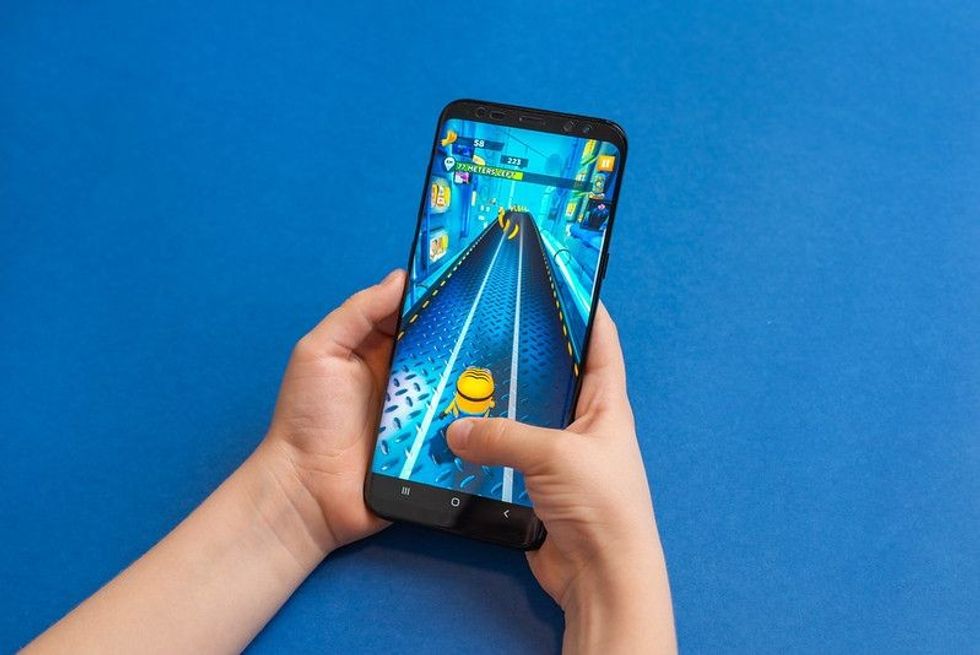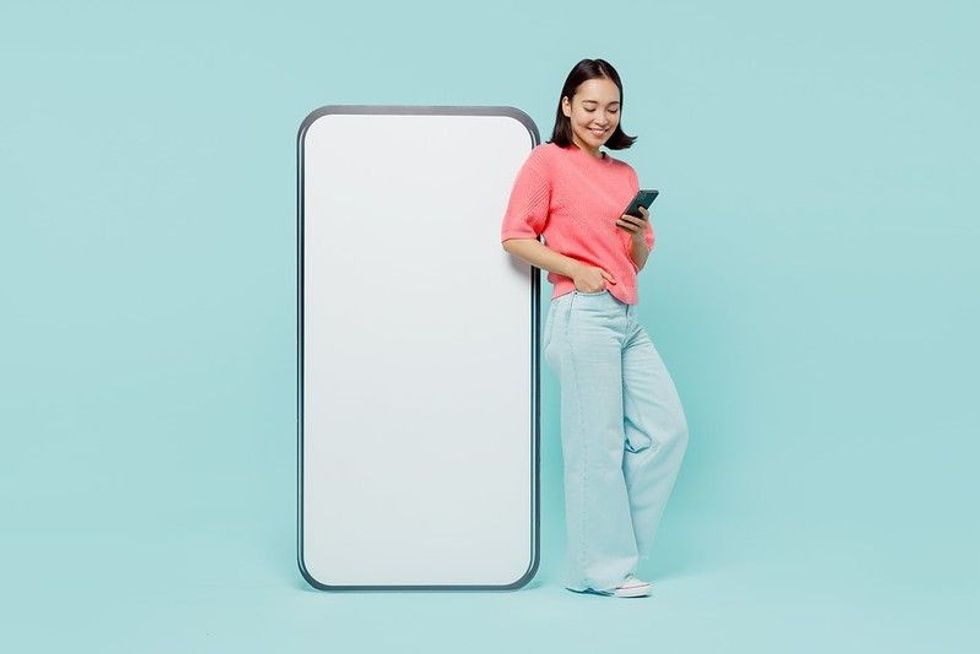67 Fun And Interesting Mobile Phone Facts For Kids

Did you know your mobile phone is more powerful than a spaceship?
Also called cellular phones or cell phones, mobile phone is one of the most loved electronic gadgets in the world right now. In the last 10 years, the kind of technological upgrades in the mobile phone industry has been spectacular.
A cell phone device uses radio signals to make and receive calls. Modern cell phones use a cellphone or a mobile network to connect to anyone from any part of the world instantly.
A cellphone network is distributed across the world in areas called cells. There are base stations present globally, and these offer network coverage that can be used to send voice and data across.
Today's smartphones support so many other kinds of services, including just calling. You can send data messages, emails, voice messages, play games, listen to songs, and connect to the World Wide Web, all from the small phone on your palm.
The United States has the largest smartphone market in the world right now. Right now, there are more than 290 million users who own smartphones in the country. The penetration rate for smartphones in the country was about 85% in 2021.
There are many advantages or perhaps disadvantages to owning mobile phones. Research says that 50 minutes of being on your phone could increase sugar usage in the brain, which is a sign of increased activity. Read to know more.
History On The Invention Of Mobile Phones
Wired phones were invented way back in 1876. People were astonished at how one could speak to someone far away with this gadget. Right now, though, there is very little a smartphone cannot do; it has certainly made lives easier and more convenient. Here are some facts about the history of mobile phones you should know about.
Scientists and engineers have always imagined the creation of a handheld telephone device, and ever since, radio technology has become popular.
Did you know that the first patent for a handheld phone was filed way early in 1917 by a Finnish engineer named Eric Tigerstedt?
His patent included details about a small phone that could be folded after use and made with a thin piece of a carbon microphone. However, his idea remained on paper for the next 56 years.
Motorola was the brand that showcased the first mobile phone in the world. Two innovators named Martin Cooper and John F. Mitchell created the first handheld mobile phone in 1973.
Can you believe that this handheld mobile device from Motorola weighed 4.4 lb (1.9 kg)? The phone was long and sturdy, with an antenna on top to grab the radio signals.
It was six years later, in 1979, that the 1G cellular network to help handheld phones send and receive signals was first introduced. This analog network was launched in Japan by a brand named Nippon Telegraph and Telephone.
Due to the growing popularity of these analog phones, the Nordic Mobile Telephone System (NMT) was launched in countries like Denmark, Norway, Sweden, and Finland.
The 1G cellular network was a promise to get away from the regular congestion and traffic of the manual phone network.
The first commercially available mobile phone was from Motorola. It was named the DynaTAC 8000X series. The DynaTAC series was continued to be released from 1983 to 1994.
The first cell phone needed to be charged for 10 full hours to have a talk time of 30 minutes! It could save just 30 numbers and cost $3995 in the year 1984. When compared to today's money, that is roughly around $9952.
From 1983 to 1998, Motorola was the clear market leader in the handphone market. After 1998, Nokia took over. It topped the charts with new handheld phones up to 2012.
This was when Samsung came up with its smartphone models and instantly gained recognition.
Twelve years after the development of 1G, Finland created the first 2G cellular network. This network was created by a brand named Radiolinja on Global System for Mobile Communication (GSM) standards.
Some of the major inventions that made cell phones a reality were the development of Large Scale Integration Technology (LSI) and Metal-Oxide Semiconductors (MOS).
History says that the existing operators on the 1G network were extremely threatened by the new operators on a better network.
Another great invention that bettered cellphones was the lithium-ion battery. These batteries offered exceptional energy to mobiles.
From having a talk time of just 30 minutes, these batteries offered multiple hours of battery life with a single charge.
NTT Docomo in Japan introduced the 3G network in 2001. This slowly improved, and 3.5G, 3G+, and turbo 3G networks were all introduced.
These enhancements in cellular networks enabled quicker connectivity and greater capacity and promoted the sales of cell phones.
Smartphones were designed as advanced types of mobile phones with the intelligence of computers. These quickly shook the market and took over the world by storm.
The first smartphone was introduced commercially by a brand named BellSouth in 1994. This phone could take calls and also send emails and receive faxes. It came with other smart features like a calendar, notes app, and appointment scheduler!
Here is another interesting mobile phone fact for you. Did you know that the name smartphone was first used commercially by the brand Ericsson in 1997 to name their GS88?
Here is one of the mobile phone facts to awe you. Did you know that more than 50% of all the phones used in the world now are smartphones? Very few people still use other types of telephone services.
Surveys say that 85% of all American adults use smartphones these days.
Types Of Software In Mobile Phones
Smartphone users and their demands have increased multifold. They are important for us as they help people connect and enjoy. Here are the different types of software in mobile phones you should know of.
The mobile Operating System (OS) is the first type of software a smartphone should have. An operating system is the brain of the device, and its functionalities depend on this. Though there are lots of OSs available, there are two popular versions - Android and iOS.
Android users need to know that theirs is the best-selling OS in the market since 2011. Android OS was first developed in 2007 and was sponsored by Google.
It was first used on a smart device called HTC Dream. iPhone users generally are very loyal to their iOS operating system.
The next software on your smartphone is messaging service. If you are a youngster, you may not have used the Short Messaging Service (SMS) option on your phone.
The current generation doesn't even know this exists. However, this is one of the software in older phones that was used extensively to send data messages.
Did you know that the first SMS was sent from a computer to a phone in 1992? Multimedia Messaging Service (MMS) was first introduced in March 2002. MMS helped people send images and videos over messages.
Mobile apps are essential software that has changed the landscape for smartphones. These are programs that are designed to run on phones.
Apple created its first app store for iPhone models in 2008. This app store had many applications across genres like music, games, videos, and books.
With this, many individual developers created their own iPhone software and Android-based phones. Google created its app store named Google Play.
The Apple App Store has 1.96 million apps available for download, as per recent reports. While the Google Play Store offers 2.87 million apps for download.

Purpose Of Mobile Phones
Phones were invented to talk to people far away. Over time, with the popularity of smartphones, the utility of these phones has completely changed. Here are some of the different mobile phone facts regarding usage.
The primary use of mobile phones, without a doubt, is to make calls. It could be to call friends, family, or peers. A mobile phone becomes a life-saving gadget during emergencies. Thanks to a large number of cell phone towers, most parts of the world have connectivity.
Overseas calls were and are very expensive. Thanks to voice calling facilities with 3G/4G/5G or Wi-Fi, you can have voice calls and video calls made to anyone in the world, literally for free. This is one benefit that smartphone users enjoy.
You can now send invitations and announce special events in life over mobile phones. Before, this had to be done in person or via mail.
A lot of people have also started watching movies and series of their choice on phones because it is convenient and can be used from anywhere.
It is now very common to see people using their phones to make and receive payments of all kinds. Banking applications and money wallets have made online transactions effortless and secure over smartphones.
People who love shopping have turned their phones into virtual shopping places. These gadgets can help you buy anything you want, from food to pets online, with the touch of your phone screen.
Smartphone users can also track their location and convert their phone into a map when they are traveling or driving.
When it comes to tracking the movements of criminals or wanted individuals, the FBI, police, and other crime departments can do this by tracking the SIM card or the device.
Cellphones are very useful. However, there are concerns regarding the ill effects of mobile phone radiation on people's health.
Several studies highlight the relationship between chronic use of mobiles and health risks ranging from eye problems to mood disorder, insomnia to text neck to cancer.
Text neck is a common condition caused by the high use of mobile phones where the user keeps looking down on their phones.
Texting thumb or trigger thumb is another mobile phone condition that results from spending a lot of time gripping or clutching mobiles.
Did you know that your smartphone contains more bacteria than a toilet bowl? Bacteria easily get attracted to mobile screens and can cause bacteria-based infections.
How Mobile Phones Changed Technology
Mobile phones have digitalized the entire globe. Today, most of the modern technologies are at our fingertips. Be it a torch or camera, calculator or recorder, internet or gaming; everything comes fitted in your palm-sized smartphone. Mobile technology has transformed many lives since its inception. Here are a few facts on how a mobile phone has changed technology.
A mobile phone is a relatively new invention. The first mobile phone was invented less than 50 years ago. However, when you compare the difference between the first mobile phone and the current smartphones, there is so much technological advancement in place.
Firstly, the computing power of a smartphone is almost equal to that of a computer.
According to experts, right now, your iPhone or any high-end phone has higher computing power than an average PC.
One of the biggest problems of the initial cell phone models was their size. They were too big and bulky to be used in one hand. Engineers were in a rush to experiment on different battery models to bring down the weight and size of the phone.
Nokia was a brand that managed to lead the market by creating very lightweight and compact cell phone models. These became instantly popular, and other brands like Samsung soon picked up the pace.
Today, many brands are striving to create the lightest and slimmest smartphone. In the year 2021, Xiaomi Mi 11 Lite won the title.
People realized that the youngsters wanted entertainment and fun, a part of these cell phone variants. Between 1998 and 2000, Nokia introduced changes like a variety of ringtones, the very popular snake game, and customized casing for all its young users.
By the 2000s, Samsung started moving up the ladder, pushing down Nokia. Their phones looked great with colored screens, smooth screen surfaces, and built-in cameras.
Cameras were the next technologically amazing change that phones offered.
The quality of phone cameras kept getting better, and right now, brands like the iPhone let people take photos with DSLR quality.
The 2010s were the period for smartphone users. They enjoyed a variety of features, and the great thing was that Apple, Samsung, and other brands like HTC and Ericsson managed to offer their iOS and Android devices at very affordable prices.
Mass production bought down the prices of phones.
The availability of the internet completely changed the game for smartphone models. Everything that computers offered were fitted in a compact smartphone.
A lot of internet providers tapped the smartphone market, and prices dropped down drastically.
Apple released its first iPhone in 2007. It became an instant hit.
Did you know in 2012, Apple sold 340,000 iPhones per day?
Because of the unmatched features that come in an iPhone, the sales are sky-rocketing despite being a high-priced commodity. According to statistical reports, 94% of the industry's profits are claimed by Apple.
Android lovers equally enjoy amazing smartphone models from brands like Mi, Samsung, HTC, and Ericsson.
People look at their phones 150 times a day on average.
Article image credit: RSplaneta / Shutterstock.com
We Want Your Photos!
More for You
See All
Bachelor of Science specializing in Computer Science

Christian MbaBachelor of Science specializing in Computer Science
Christian Mba is an experienced blogger and content writer with over a decade of experience. He holds a Bachelor of Science degree in Computer Science from Nigeria and has a keen interest in Python programming. Along with his writing and blogging expertise, he is also an SEO specialist with more than six years of experience. Chris, as he is commonly known, has a passion for music and enjoys playing the piano.
Disclaimer
1) Kidadl is independent and to make our service free to you the reader we are supported by advertising. We hope you love our recommendations for products and services! What we suggest is selected independently by the Kidadl team. If you purchase using the Buy Now button we may earn a small commission. This does not influence our choices. Prices are correct and items are available at the time the article was published but we cannot guarantee that on the time of reading. Please note that Kidadl is a participant in the Amazon Services LLC Associates Program, an affiliate advertising program designed to provide a means for sites to earn advertising fees by advertising and linking to Amazon. We also link to other websites, but are not responsible for their content.
2) At Kidadl, we strive to recommend the very best activities and events. We will always aim to give you accurate information at the date of publication - however, information does change, so it’s important you do your own research, double-check and make the decision that is right for your family. We recognise that not all activities and ideas are appropriate for all children and families or in all circumstances. Our recommended activities are based on age but these are a guide. We recommend that these ideas are used as inspiration, that ideas are undertaken with appropriate adult supervision, and that each adult uses their own discretion and knowledge of their children to consider the safety and suitability. Kidadl cannot accept liability for the execution of these ideas, and parental supervision is advised at all times, as safety is paramount. Anyone using the information provided by Kidadl does so at their own risk and we can not accept liability if things go wrong.
3) Because we are an educational resource, we have quotes and facts about a range of historical and modern figures. We do not endorse the actions of or rhetoric of all the people included in these collections, but we think they are important for growing minds to learn about under the guidance of parents or guardians.







